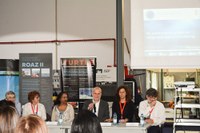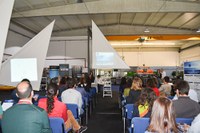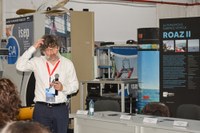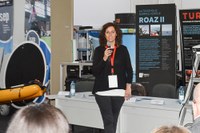MARINEYE CREATES A PROTOTYPE TO MONITOR THE OCEANS
INESC TEC CREATES AN AUTONOMOUS SYSTEM TO MONITOR the OCEANS IN AN INTEGRATED WAY
Through the new MarinEye project, a group of INESC TEC’s researchers have created an autonomous system that monitors oceans in an integrated way, allowing a more sustainable management of sea resources and a reduction in the impact of environmental hazards.


A new project of marine research
This system was presented on the 6th of May, at the Centre for Robotics and Autonomous Systems (CRAS) of INESC TEC, where the different technologies of the multitrophic system were shown.
The concept of integrated monitoring of the oceans developed by the researchers of the MarinEye project (a multitrophic prototype to monitor oceans) will provide tools that allow spotting changes in biodiversity.
This project, led by CIIMAR - Interdisciplinary Centre of Marine and Environmental Research, was developed in collaboration with several Portuguese research groups, namely INESC TEC, IPMA, and MARE – IP Leiria).
Prototype structure
The presented prototype is made of several modules.

A multi-sensor system will integrate different physicochemical sensors, which, in turn, will measure indicators such as temperature, salinity, dissolved oxygen, and pH, amongst others, and a platform of optical sensors that will be validated in order to measure dissolved carbon dioxide.
Other elements include a high-resolution imaging system capable of collecting images of phytoplankton and zooplankton in order to evaluate their abundance and biodiversity, and an acoustic system capable of collecting hydroacoustic data in order to gather information concerning the presence of marine mammals and estimate the abundance of fish.
Finally, an autonomous filtration system was developed to filter and preserve the DNA/RNA of the different size classes of the microorganism communities that inhabit and represent the biggest ocean biomass.
The system also includes a platform for the integration of the different types of data that will be generated. Associated with this platform there is also a software that can be used not only to view and summarize the data, but also to develop a series of models whose purpose is to integrate and identify interrelations between the different chemical, physical and biological parameters gathered through the different modules.
The importance of maritime exploration for the future
The habitability of our planet depends on oceanic processes, but until now, it was not viable to simultaneously observe and interpret the different components of the ocean, together with different trophic levels, from microorganisms to marine mammals.


“We are convinced that the concept of integrated and synchronised monitoring of physical, chemical and biological parameters, in time and space, implemented in MarinEye, is essential to gather knowledge on the complexity of the marine ecosystem. In the near future, it will certainly be implemented in different oceanic observatories”, mention Catarina Magalhães, researcher of CIIMAR and coordinator of the project, and Eduardo Silva, Coordinator of CRAS.
The researchers say that the goal for the future is to operationalise this technology in a real context and to integrate new technologies into this prototype, such as biosensors, so that it can collect the maximum amount of information on the different levels of the biological compartment in situ.
A multidisciplinary team

The four national partners that form the MarinEye team have different roles. CIIMAR is the promotor of the project and, together with IPMA and MARE, they have gathered biologists and chemists from different areas, who are responsible for the validation of the variables obtained through the different modules of MarinEye. INESC TEC provided a team of researchers in the field of robotics, a team specialised in developing optical fibre sensors and a team of researchers specialised in data analysis, who are responsible for the development of the robotics components, optical sensors and the data visualization and integration software, respectively.
Project MarinEye (PT02_Aviso4_0017) is funded by the EEA Grants programme by an amount of about €400,000.
The researcher mentioned in this news piece is associated with ISEP-P.Porto.
Photo credits: http://marineye.ciimar.up.pt


